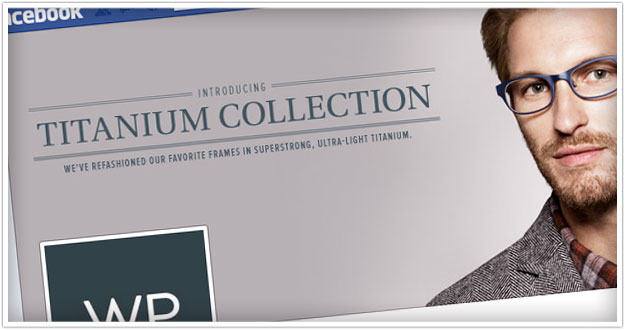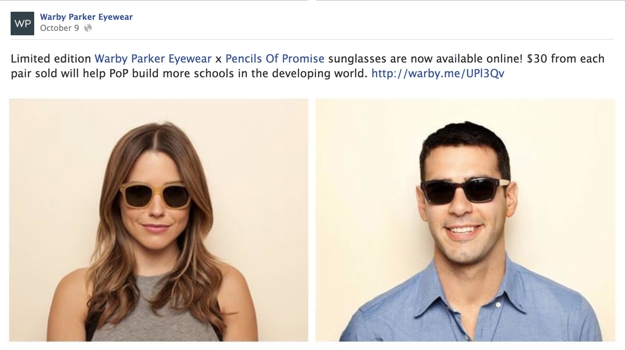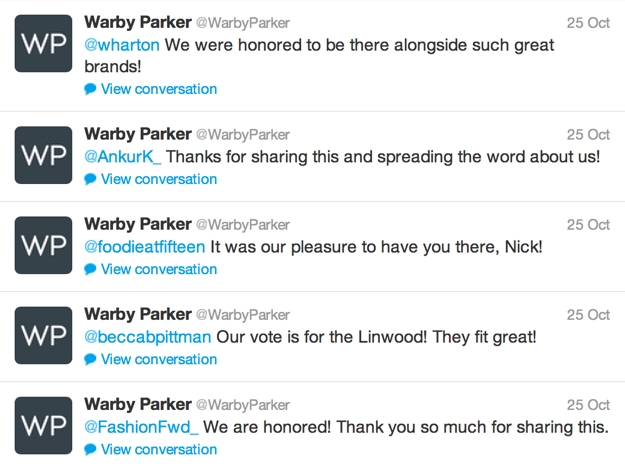How Warby Parker Conquered Social Media (And You Can Too)
November 2012
By Natalie Lynn Borton

Warby Parker is an eyewear company on a mission. In 2010, co-founders Neil Blumenthal, Dave Gilboa, Jeff Raider and Andy Hunt set out to revolutionize their niche by creating boutique-quality, classically crafted eyewear at a revolutionary price point.
Today, they sell frames and lenses together for a flat low price of $95. Not only do they produce a high-quality, affordable product, but they also do so with a conscience: for every pair of glasses sold, a pair is given to someone in need.
It’s an indisputably great concept. But how did they skyrocket to success so quickly? Well, they had a little help – from the community of followers and evangelists they’ve cultivated through their activities on key social media networks, specifically Facebook, Twitter and Pinterest.
While their business model may be unique, their approach to community building offers great lessons in social engagement that you can implement to fast-track the growth of your business:
Facebook

How they did it: Warby Parker is currently just shy of 100,000 followers and still growing daily. The strength of their appeal on Facebook lies in their prolific use of images through status updates, albums and user engagement campaigns.
Since the arrival of the Facebook timeline, images are more important than ever. According to Facebook Marketing, “photos and videos get 120% and 100% more engagement respectively.”
How you can do it: The equation is simple: more images means more interaction, so it’s time to get visual.
Here are a few simple ways you can amp up your use of photos and videos on Facebook:
Attending an event? Snap a photo or video and post it to your page. For greater convenience, install the Facebook Pages app on your smartphone so you can share on the spot without needing to be near a computer.
Published a new blog post? Share the photo you used in the post, then caption it with a catchy hook followed by “Read more here:” and the URL.
Just released a new collection of products? Create an album featuring a photo for each new item in your link along with a quick description and a link to your e-commerce site to drive sales.
Twitter

How they did it: With nearly 28,000 followers to date on Twitter, Warby Parker (@WarbyParker) has a well-branded page and a strong team of community-builders behind their tweets. One of their strongest assets is their consistency in responding to customers, potential customers and fans.
Take a quick peek at their Twitter page, and you’ll instantly notice an unending list of tweets in direct response to another Twitter user. According to Carol Rozwell, vice president and analyst at Gartner, “The dissatisfaction stemming from failure to respond via social channels can lead to up to a 15 percent increase in churn rate for existing customers.”
While it’s impossible and impractical for a growing company to respond to every mention on Twitter, it’s an important practice to engage as much as possible with the community. From my own personal experience I can say that I’m much more likely to be a loyal customer of and an evangelist for a company, product or service that responds to me than one that doesn’t. Not surprisingly, my personal choice of eyewear is, in fact, Warby Parker, and much of that has to do with the responsiveness and excellent customer service they provide through Twitter.
How you can do it: Responsiveness is the name of the game. You should try to over-serve your customers at every turn.
The most efficient way to do this is to assign a specific person — ideally a customer service specialist who is also socially savvy themselves — to monitor your Twitter feed on a daily basis. By delegating the task to one person, you can ensure that your responses are consistent, timely and safeguard the value and reputation of your brand. With the pace at which the social media world moves, if a comment or concern from a follower lingers for even a few hours unanswered, people will take notice and will perceive that you have ignored their tweet.
One important cautionary note: if a follower brings up a problem, acknowledge it publicly, then resolve it privately via phone or email.
Pinterest

How they did it: Much like they’ve done with their Facebook presence, Warby Parker has used the power of images to connect with their customers on Pinterest. They currently have over 6,000 followers, 27 boards, 1,800 pins and more than 1,600 pin likes.
It’s worth noting that they are using Pinterest in exactly the right manner – not as a tool for shameless self-promotion but rather as a vehicle to provide greater value to their customers and to create an overall image for the brand that people gladly want to identify themselves with. For example, one of their boards is called “Jasper: A Vintage Outlook,” and simply features vintage-inspired images that echo the brand’s look and feel.
Another technique they use is cross-promotion. On their “Bespectacled Bloggers” page, they feature bloggers wearing Warby Parker frames. This serves to not only add credibility to the brand, but also to increase traffic to blogs that support Warby Parker. It’s a win-win.
How you can do it: Focus on providing value first and foremost, and allow promotion to happen organically as your followers take your great content and run with it.
Self-promotion need not be avoided completely; however, it’s important to do so in a tasteful fashion and not to let your social media sites be solely focused on you. This will allow you to generate a real community around your brand, product or service, because you’ll become a source rather than a salesperson.
Much like Warby Parker has done with their Pinterest page, think about the kind of things your consumers are interested in (other than your product), and provide valuable content based on that. People will be more inclined to engage with what you post when it’s valuable to them, rather than when they feel like they’re being sold something all the time.
Natalie Lynn Borton is a magazine editor, writer, blogger and freelancer. With a degree in Public Relations and Marketing from Pepperdine University, she is a professional communicator and a unique blend of perfectionist and creative-type. She currently lives in San Diego, where she works remotely as a Managing Editor for Darling Magazine. You can find her blogging at Thoughts by Natalie, and learn more about her freelance work at www.natalielynnborton.com.